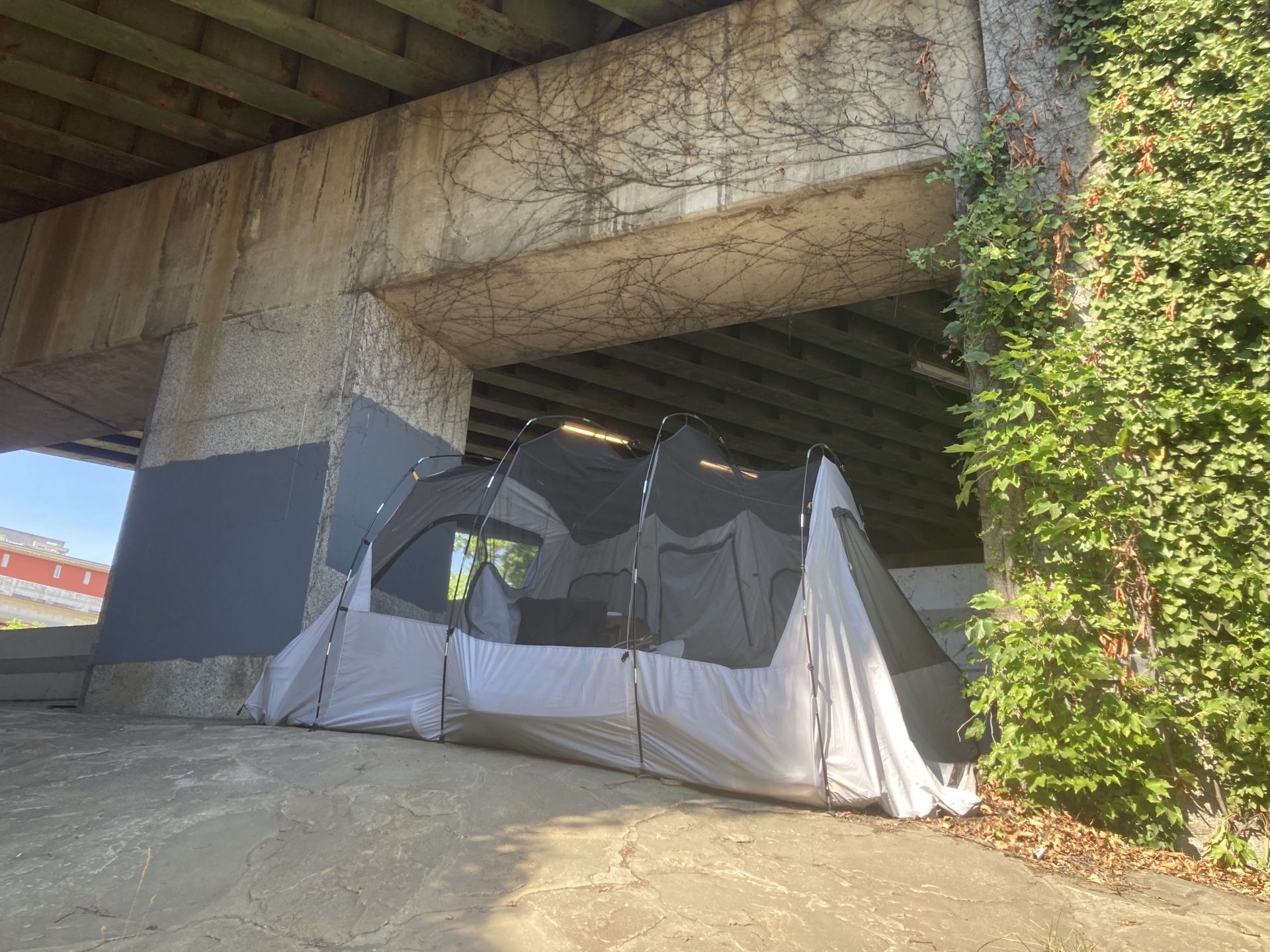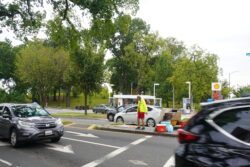Editor’s Note: This piece is published as part of The Homeless Crisis Reporting Project (HCRP), launched by Street Sense Media in 2016. HCRP is a multi-day collaborative effort between local D.C. outlets to spotlight homelessness and related issues in the District. Check out all the 2024 HCRP stories here.
As soon as the sun rose, the polyester walls of Cherie’s tent felt suffocating. This summer, she had to make sure to not spend too much time in her tent during the day—for fear of passing out from the heat.
“I would toss and turn in my tent, unable to fall asleep most nights,” Cherie said in an interview with the Voice.
It was difficult for her to be in her tent even after sunset; the floor in particular retained uncomfortable levels of heat long after the hottest part of the day.
This summer was the third hottest in D.C.’s history, with the district seeing triple digit temperatures for the first time since 2016. During one July heatwave, D.C. experienced four consecutive days of highs over 100. One day reached a scorching 104, a temperature which the Washington Post reports the city has only reached 12 times prior.
This summer, D.C.’s government declared 15 heat emergencies and four extended heat emergencies, according to the Office of the Deputy Mayor for Health and Human Services (DMHHS). This amounted to at least 28 days, where the heat index—a measure of how hot it feels with both temperature and humidity—reached 95 degrees or higher.
According to D.C.’s Heat Emergency Plan, prolonged exposure or strenuous activities in temperatures and humidity this high can lead to serious medical emergencies. There is a heightened risk of heat exhaustion, stroke, and worsening existing conditions.
DC Health reported 390 heat related EMS illnesses—cases where emergency services are called and the patient exhibits symptoms of overheating—in 2024. Yet, the Interagency Council on Homelessness does not track how many of these are people experiencing homelessness, DMHHS wrote to the Voice.
Living in an urban center like D.C. further exacerbates the intensity of the heat, as the higher concentration of infrastructure compared to suburban or surrounding areas causes an increase in temperatures. Concrete and asphalt retain heat, reaching temperatures much higher than grass would absorb with the same sun exposure. D.C. ranks sixth among cities which are affected by the “heat island” effect, with an average increase of 8.5 degrees as reported by Axios.
Temperatures this high are difficult for everyone—not just people living outside. During heatwaves this summer, D.C. saw canceled outdoor summer programs for kids, Metro delays due to rails bent from the heat, and an uptick in heat-related hospitalizations.
But, Cherie is one of many—more than 9700 individuals—who endured this record-breaking summer while experiencing homelessness. And staying cool and healthy during periods of extreme heat is very difficult for those living in encampments.
“You can’t oversleep, you have to be careful of the heat in the morning,” Cherie said.
When D.C. reaches extreme temperatures, prompting heat emergency declarations, D.C. recommends that people stay indoors, avoid sun exposure, and drink plenty of water.
These precautions can be hard to follow for living outside, putting many experiencing homelessness at a higher risk of heat-related illnesses such as heat exhaustion and, if left unaddressed, heat stroke.
In the event of a heat emergency, D.C.’s Homeland Security and Emergency Management Agency (HSEMA) activates their Heat Emergency Plan, which opens several cooling centers, in an effort to provide places for those experiencing homelessness to seek relief from the heat. These are designated locations—low-barrier shelters, day centers, public libraries, recreation centers, and public pools—where people can spend time indoors during the day.
With extreme levels of heat this summer, cooling centers were essential for many of those living outside, including for Cherie, who frequently visited the Downtown Day Center.
“Shelters across the city were highly utilized this summer—above 90% occupied for both men and women,” a DMHHS official wrote in an email to the Voice.
At Miriam’s Kitchen, a local homelessness outreach organization and one of DMHSS’s demarcated cooling centers, visitors were welcome to take refuge in the air conditioning and have a meal.
“We are a place where, especially with high heat, for a few hours a day, someone can come inside to be in the cool, get water, get food, get supplies,” Adam Rocap, deputy director of Miriam’s Kitchen, said in an interview with the Voice.
While Miriam’s Kitchen is not a cooling center, they provide similar services, and work to educate those coming in about the dangers of high heat and how to prepare. Rocap said that days ahead of predicted heatwaves, the staff at Miriam’s Kitchen begins informing those coming for meals and offers them help to plan for the heat. They also provide information about official resources.
“We’re, from that dining room setting, telling people, ‘Hey, when there’s a heat emergency, these are the extended hours at the libraries. Or this is where the cooling center is at the downtown Day Services Center,’” Rocap said. “It’s being a place where you can come and handing out extra water, sunscreen, and giving people the information about where to go.”
Despite the various official resources, it can be difficult for people experiencing homelessness to reliably access them, as many cooling centers have limited hours, restrictive policies, or are inaccessible to those living outside. Cooling centers are also only open during the day, despite nights seeing little reprieve from the heat and temperatures not dipping below 80, according to WUSA9.
Of the 53 cooling centers listed by HSEMA, two-thirds were confirmed to be open during heat emergencies this summer, according to reporting from Street Sense. Restrictions based on age and gender further narrow the options for people experiencing homelessness.
Entry to cooling centers can also create a hard choice for people between keeping their belongings safe and seeking relief from the heat. Some centers have a strict two-bag limit, meaning people who carry all their belongings with them may have to leave some of their possessions outside, where they might be lost or stolen.
Miriam’s Kitchen is cognizant of this potential barrier and has taken steps to allow for reliable and inclusive access.
“We have an area set up outside where people can store those things, or just keep them outside while they’re there in the dining room, and our security is out there,” Rocap said. “So a lot of people, if they have a lot of large belongings, feel comfortable.”
However, it remains a problem at many of the official centers.
Cherie took advantage of cooling centers, but found that they only provided limited relief from the heat and many did not provide enough privacy.
“D.C. needs more designated spaces where people can stay without uncertainty and centers more geared to privacy,” Cherie said.
Martin Luther King Jr. Memorial Library is a popular gathering spot for people seeking relief from the heat, as the open floor plan with extensive seating options and private study cubicles provided a variety of options. Cherie especially valued the library because it provided her a sense of security and created a more private space of her own. She hopes that the D.C. government will create more centers which carve out personal space through individual rooms and tables.
As the city grapples with the consequences of extreme temperatures, local advocates like Rocap urge the D.C. government to prioritize long-term solutions to address homelessness.
“The real way that someone’s going to be the safest from heat emergencies or outdoor heat, is to have their own place, to live in their own apartment, where they can be safe indoors,” said Rocap.
Rocap explained that the answer to addressing the dangers of extreme heat for people experiencing homelessness is ensuring greater access to permanent housing. The District’s budget for 2025 included substantial cuts to services like Rapid Rehousing, the Emergency Rental Assistance Program, and outreach programs. Rocap emphasized the importance of making sure there is enough funding for vital housing services like these, which Miriam’s Kitchen and other local homelessness organizations urge the District to secure.
“What we advocate for year in and year out, is funding for enough housing to end homelessness, because homelessness is not something that we don’t know the answer for, ” Rocap said.





